TOUGH TIMES AHEAD
For grassroots facilities
by TurfPro Editor, Laurence Gale MSC, MBPR
How many grassroots sports clubs will be able to afford the new equipment required to maintain their surfaces, considering many of them are struggling already to maintain the current batch of machinery in their sheds?
I feel the recent SALTEX show reignited our industry by allowing people to meet up face-to-face again after the long delay caused by the pandemic. The opportunity to meet suppliers and manufacturers was welcomed by many grounds professionals.
On show was a plethora of new machinery that included many battery and robotic products that are being introduced to replace traditional fuel driven vehicles and machines - which will no doubt be phased out in the coming years.
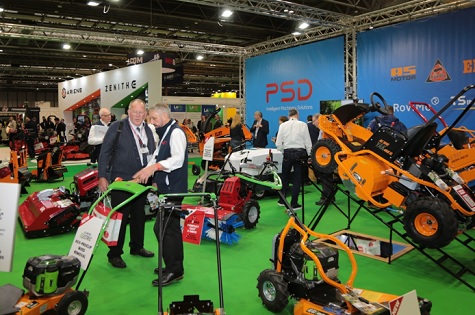
We are beginning to see a dramatic shift to new technologies that are aimed at reducing carbon emissions and safer ways of working. However, the cost of development and delivery of these new machines is coming at a premium, with many battery replacement products costing up to double that of conventional fuel driven products.
For me, it will be interesting to see how many grassroots sports clubs will be able to afford these new products, especially when many of them are struggling already to maintain their current batch of machinery in their sheds.
I believe if we are going to retain the current level of community sport participation, we will need a substantial aid grant from government, or the sporting bodies, to ensure sports clubs are fit for purpose and able to deliver a decent playing surface in the coming years.
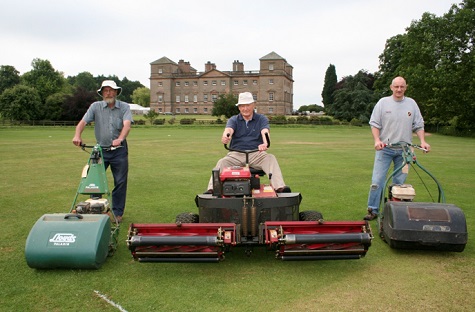
Some key issues facing many clubs is the fact that they are finding it difficult to raise enough money for appropriate funding of equipment to maintain their pitches - along with finding willing volunteers to undertake this work.
The aftermath of Covid has left many clubs in financial trouble and more importantly it may have deterred some members from returning to their clubs.
The next few years will be a critical time for clubs to adapt and get back to what they do best in providing the next generation the chance to participate in sport.
Raising the required funds
Clubs will have to be more proactive in securing funds and, crucially, in finding future volunteers or paid professionals to undertake the work of maintaining their surfaces.
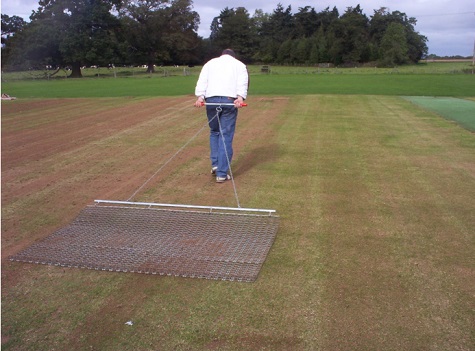
I read with interest that the ECB has set up a funding opportunity to help clubs get over the pandemic.
Also interesting is the news that Middlesex Cricket is partnering with the Grounds Management Association (GMA) and Capel Manor College with a view to running apprenticeships for those wishing to work in cricket groundsmanship in 2022 and beyond.
Apprenticeships are expected to commence full-time in March 2022 and run for a minimum of 18 months, providing all aspects of training and experience in cricket grounds maintenance. Course costs are 95% funded by the government.
This in my opinion is a very good initiative and hopefully it will translate into a bigger scheme. I could easily see other cricket counties taking on apprentices and sharing them with local clubs to gain relevant hands-on, practical experience - along with other sporting governing bodies following suit. If the government is keen to embrace and promote this apprenticeship scheme, then the opportunity to bring new people into the industry must be complemented.
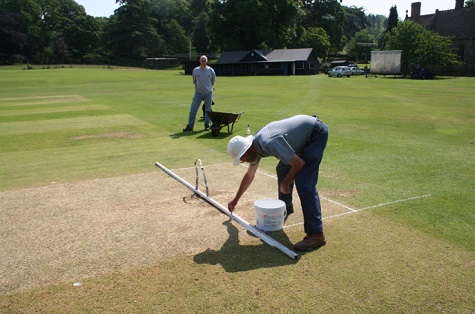
I know the GMA are currently working on opportunities to develop industry related apprenticeship schemes and there’s no doubt scope for further dialog to encourage even more people to have the opportunity to work in our diverse turf industry.
Personally, I like to think that between the government, sports governing bodies and private companies we could have the opportunity to develop and finance a national apprenticeship scheme that could see over 1000 apprentices a year coming into the industry over the next five years.
However, having said all that, the clubs themselves need to be more mindful of the costs of running their clubs and more importantly invest an appropriate amount of money to ensure their pitches are fit for purpose.
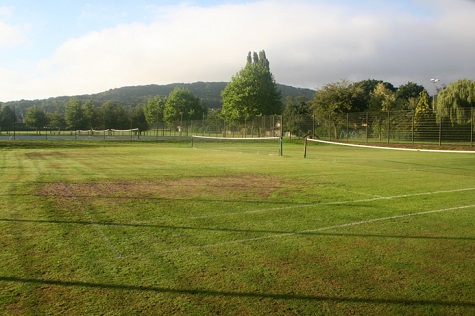
There are no short cuts. In the main many clubs rely heavily on the good will of the volunteer members to maintain their pitches, sometimes having to use poor or unsafe machinery.
It is now time clubs realise the true cost of maintaining their facilities. I recently wrote an article named Identifying True Values highlighting the costs of maintaining a grassroots sports facility.
In essence these costs are only a guide, but the article shows that there is a substantial cost to providing machinery and getting the annual maintenance achieved on a grass roots sports facility.
 |
|
 |  |
STEVENAGE FC SAY IT'S THEIR BEST EVER SEASON
For plant strength and surface performance
In our first WEB ONLY story, head groundsman, James Fennessy, notes the resilience demonstrated by their surface, meaning they’ve seen no disease on the stadium pitch this year.
COMPANY CLOSURE LEADS TO DISTRIBUTION CHANGES
For Grasshopper mowers
In our next WEB ONLY story, it has been announced that the import of the Grasshopper range of zero-turn mowers for the UK & NI has changed due to the upcoming retirement and closure of the previous distributor.
SEMINARS HELP BOWLS CLUB IMPROVE SURFACES
Improvements to green
Rykneld Bowling Club, in Derbyshire, has seen major improvements to the green after an investment in equipment and visitong a virtual bowls seminar portal.
Rykneld Bowling Club, in Derbyshire, say they have benefited from a new SISIS Auto Rotorake Mk5 and have seen major improvements to their green after various committee members enhanced their greenkeeping knowledge through the Dennis and SISIS virtual bowls seminar portal.
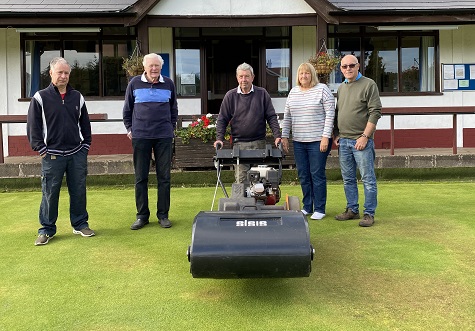
Rykneld Bowling Club
“Lately we have been getting great feedback,” said committee member Malcolm Holden. “That is not only from our own members but also from visiting teams. The improved surface has enabled us to have a South Derbyshire Premier League team excelling at the club.”
Five committee members work hard to maintain their green. They have recently enhanced their greenkeeping knowledge after becoming members of the free Dennis and SISIS virtual bowls seminar portal.
On the portal, members have access to regular, updated video seminar sessions on a wide range of relevant topics written and hosted by expert speakers. Users can also ask questions to the various experts and tap into their experience and knowledge. Other resources on the portal include downloadable PDF’s containing seminar content, case studies, videos, links to key products and vital information on funding.
“We have been following the videos on the portal religiously,” said Malcolm. “The portal is fantastic, and it covers every kind of topic you can think of when it comes to greenkeeping. We document everything we do, and the virtual seminars are helping us to continuously improve the green.”
Thatch is one particular issue that Malcolm and the team have been trying to solve through the seminar portal. Recently their efforts were boosted after the club purchased a SISIS Auto Rotorake Mk.5.
“The green has built up about 100 years of thatch, and it is slowing the green down,” said Malcolm. “It is not going to be a quick fix, but we are really stepping things up with the Auto Rotorake now.
“We’re already starting to see progress because of the amount of air it is helping us to get into the soil."
 |  |
STAFFS FA CONTINUE PARTNERSHIP
With equipment manufacturer
One of the key strands of the Staffordshire FA grass pitch improvement strategy, is to support clubs to be able to invest in equipment to maintain their playing surfaces.
Following on from a successful working relationship with Campey Turf Care over several years, including the development of a formal partnership in 2020, Staffordshire FA have confirmed they have extend their partnership with Campey Turf Care for the 2021/22 Season, as the Association’s recommended equipment supplier.
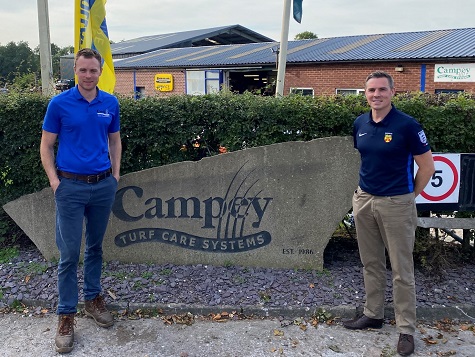
John Campey, director at Campey Turf Care and Gareth Thomas, partnerships & communications officer at Staffordshire FA
One of the key strands of the Staffordshire FA grass pitch improvement strategy, is to support clubs and turf professionals to be able to invest in equipment to maintain their playing surfaces, and for several years now, Campey Turf Care have developed an excellent reputation and relationships with many clubs across Staffordshire.
As the Football Association and Football Foundation continue to invest in the ongoing improvement of grass pitches, there has never been a better time for grassroots clubs to embrace the support and resources which can enhance their playing surfaces, and subsequently improve the experience of their members.
Gareth Thomas, partnerships & communications officer said, “Staffordshire FA have been actively working to improve grass pitches across the county since 2012, and we continue to be very encouraged by the positive impact our programme is having. However, there is still plenty of work to do with over a thousand pitches across the county, and we can only achieve our objectives by working together with various key partners across the industry.
“Campey Turf Care have played a key part in supporting Staffordshire FA and our member clubs during that period, not only with the supply of quality equipment, but also via valuable education and aftercare with our clubs and volunteers, and support with the educational workshops we deliver.
He continued, “Grassroots football clubs can access support via the Football Foundation ‘Pitch Power’ process, which in turn provides clubs with a detailed report and recommendations from our Regional Pitch Advisor at the Grounds Management Association. Included within each Pitch Power report is a section on recommended equipment, which clubs can then access 75% funding for, via a grant from the Football Foundation.
“On receipt of their Pitch Power report, clubs across Staffordshire regularly ask us where they can access quality equipment to invest in; having a trusted partner like Campey Turf Care really assists the County FA and our clubs with that process, and we look forward to developing the partnership and supporting more of our clubs in 2021/22 and beyond.”
John Campey, director at Campey Turf Care, commented, “We are delighted to extend our involvement with Staffordshire FA for the coming season. Working together we have provided a vital link between manufacturer/supplier and those in the field. Combining our innovation and expertise in product design with education and hands-on experience from grassroots clubs is a powerful step in achieving best practise at every level.”
 |  |
38 YOUNG APPRENTICES GRADUATE
Achievements recognised at special event
Talented young service technicians and parts personnel from dealers around the country have successfully graduated from manufacturer's scheme - with individuals singled out for particular honours.
The latest group of talented young service technicians and parts personnel have successfully graduated from John Deere’s Ag Tech, Turf Tech and Parts Tech advanced apprenticeship programmes.
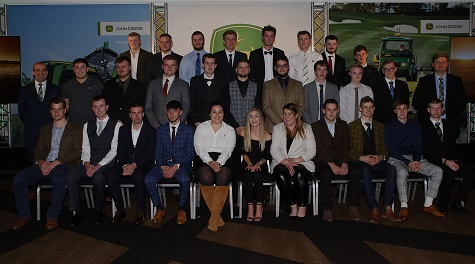
38 successfully graduated from John Deere’s apprenticeship programmes, although not all could attend the event
The 38-strong cohort passed the national scheme - provided by ProVQ - and their achievements have been recognised at a special event held for them at the Crowne Plaza in Nottingham.
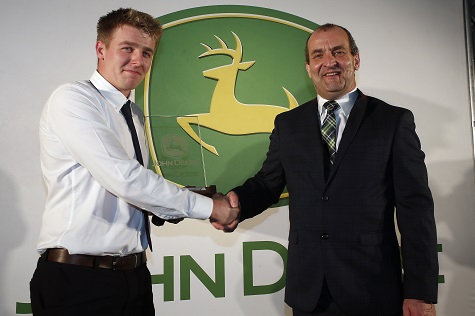
James Skipper from Ben Burgess in Beeston won the Ag/Turf Apprentice of the Year, presented by John Deere Training Centre Manager Allan Cochran
John Deere dealer Ben Burgess saw success for two of its staff with James Skipper from Beeston in Norfolk winning the Ag/Turf Tech Apprentice of the Year for 2021 while Madeleine Green from the company’s Oakham site in Rutland won the Parts Tech award.
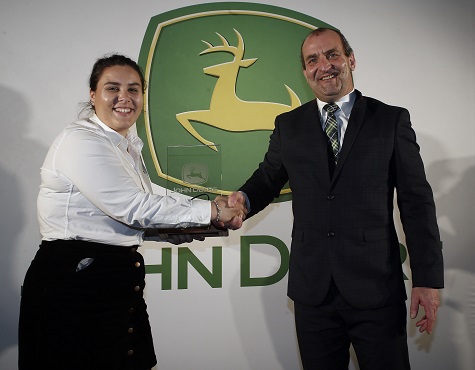
Madeleine Green from Ben Burgess's Oakham site in Rutland won the Parts Tech award
Both were presented with new Apple iPads as their prize by John Deere apprentice centre manager James Haslam.
Farol saw its Ag/Turf Tech apprentices Ciahran Quick from the company’s Shefford Woodlands dealership in Berkshire, and Henry Atkins from Midhurst in West Sussex, pick up the runner up prizes of a certificate and high street vouchers worth £250.
John Deere branch training manager Allan Cochran said, “Our apprenticeship programme has been running for nearly three decades and was created because we saw the trend of fewer people coming into the industry. We needed to take steps to ensure that there was new talent to fill our business and dealer network.
“That work is as relevant today as it was then. To see these fantastic individuals graduating from their courses and taking the next big step in their careers is incredibly rewarding.
“Helping to give these young people their first step on the career ladder builds a strong foundation for their future success, and John Deere places great importance on supporting them to reach their full potential.
“We aim to nurture and mould these enthusiastic apprentices who have the skills and desire to work in our business and across the industry.”
The next intake is already being enrolled with 61 Ag Tech and Turf Tech technicians so far signed up for their three-year course, in addition to six Parts Tech apprentices who study for two years.
The full list of graduates and employers is below:
Ag/Turf Tech
- Sam Freemantle, TAG (Bibury)
- Harry Bowers, TAG (Evesham)
- Ryan Viney, C Smart (Dorchester)
- Harry Cross, C Smart (Bridgewater)
- James Skipper, Ben Burgess (Beeston)
- Jamie Mallett, P Tuckwell (Worlingworth)
- Owen Rutherford, Thomas Sherriff
- Jared Schreuder, Thomas Sherriff (Jedburgh)
- Andrew Jarvie, Thomas Sherriff (Lietholm)
- Edward Aldworth, Masons Kings (Exebridge)
- Samuel Bullen, Doubleday (Spalding
- Robert Jacques, Farol Ltd (Hinkley)
- Jordan Cameron, Netherton Tractors Ltd - Glen Rothes
- Aaron Crebbin, Ben Burgess (Beeston)
- William Thomas, P Tuckwell (Cromer)
- Alec Murdoch, J S Montgomery (Bieth)
- Brandon Mallaburn, Thomas Sherriff (Alnwick)
- Andrew Bouch, Thomas Sherriff (Hexham)
- Sam Baxter, Ripon Farm Services (Louth)
- David Cox, Burden Brothers (Stockbury)
- Toby Saxby, Burden Bros (Stockbury)
- Harry Crane, Ben Burgess (Norwich)
- Harry Fairhead, Ben Burgess (Norwich)
- Toby Stannard, Ben Burgess (Norwich)
- George Stanger, Ripon Farm Services (Hull)
- Joe Robertson, Netherton Turriff
- David Wooliscroft, Farol Ltd (Hinkley)
- Ciahran Quick, Farol Ltd (Shefford)
- Henry Atkins, Farol Ltd (Midhurst)
- Richard Dart, Masons Kings (Exebridge)
- Campbell Morrison, Netherton Nairn
Parts
- Luke Chidley, Rea Valley Tractors
- Peter Melton, Ben Burgess (Beeston)
- Gaby Seaton, J S Montgomery (Beith)
- Lewis Blair, Thomas Sherriff (Haddington)
- Madeleine Green, Ben Burgess (Oakham)
- Karl Watson, Ripon Farm Services (Market Weighton)
- Aleisha Ireland, Farol Ltd (Thame)
 |  |
REFORM METRAC APPOINT NEW DEALER
Specialist tractor range
Simon Richard, UK Agent for the range of tractors has announced the latest dealer to join their network.
As an addition to its current range of over 25 franchises, the Ben Burgess group has been appointed as Reform Metrac dealers for the east of England.
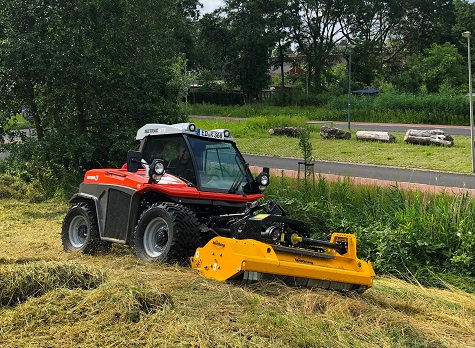
Chris Pateman, commercial manager for the groundcare sector said, "We had identified a gap in the market in our region and the high quality and performance capability of the Reform range made it the ideal choice for our business.
"We already have orders in place for two Metrac H75 and two Metrac H60 models and look forward to introducing these machines to customers from April 2022 at our branches."
Simon Richard, UK Agent for the Reform Werke specialist tractor range added, “We are delighted to be working with the Ben Burgess group."
HARBORNE UPGRADES FLEET
Invests in machinery
Harborne Golf Club in Birmingham say they have again evaluated and invested, upgrading its fleet with three new machines chosen specifically to focus on improved course presentation.
Harborne Golf Club in Birmingham say they have again evaluated and invested with Reesink Turfcare, upgrading its Toro fleet with three new machines chosen specifically to focus on improved course presentation.
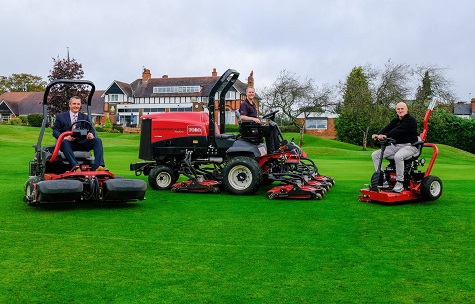
Course manager Jim Gilchrist (right) with David Timms (left) and Dan Tomberry from Reesink
The 6180-yard par 70 parkland course, famous for its fast, sloping greens, will now benefit from a brand-new Groundsmaster 4500-D rotary mower, a Greensmaster 3250-D and a GreensPro 1260 riding greens roller.
The club says these new machines will enable course manager Jim Gilchrist, who has been overseeing the club’s greenkeeping team of five for 17 years, to keep the classic and unspoilt 1893 Harry Colt design in pristine condition while saving time and money all year round.
After spending time with the new fleet, Jim says he chooses the Groundsmaster 4500-D rotary mower as his standout. “It has improved course presentation immensely from our previous rough mower," he said. "It covers more ground, reducing the time it takes to cut the roughs by half a day allowing us to focus on other areas on the course.”
Excited about the noticeable improvements, Jim is already planning more projects for the course, which include greens drainage using PC (Passive-Capillary) drainage on all 18 greens over the next few years. The club is also set to renew its frontline cutting machinery with Toro next year.
“During my time here, Toro has been instrumental in allowing us to achieve our goals over the years with the continued improvement on machinery and customer support. We have been an all-Toro club since 2012, and it has been all we could have asked for in terms of professionalism and reliability,” Jim explains.
“Dan Tomberry and David Timms from Reesink have been very supportive since they have taken on their new roles with the company, especially during the pandemic. They have made the whole process seamless and easy, so of course we’ll keep coming back to them. The Toro service centre Redtech is another big pillar in our line of work – Graham Hall and his team have been there for us from the very beginning for everything we’ve needed.”
Despite the difficult past few months, Jim believes there will always be opportunities for the industry to prosper. He says: “We have dealt with lockdowns, staff shortages across the business, and golfers’ expectations on their return. However, I feel that everyone came together for our club - from the committee to management and staff, they have all handled the whole process extremely well.
“The club, our members and our visitors have all appreciated the hard work and challenges we have faced over the last 18 months. Their support is what keeps us going and we will continue to make improvements on and off the golf course in the coming years."
 |
|
 |  |
ADVERTISE YOUR JOBS HERE
Amazing success rates!
Advertise your recruitment needs on TurfPro Weekly Briefing and reach our targeted audience of recipients every week.
Contact Nikki Harrison for details - 01491 837117
|
 |  |
EDITOR'S BLOG ARCHIVE
Catch up with Laurence Gale's recent blogs
Want to catch up with one of editor Laurence Gale's blogs? Here is the place to do so.
 |  |
TURFPRO FEATURE ARCHIVE
Find our previous features here
If you want to catch up with any of TurfPro's previous features, here is the place to do so.
WORKING TOGETHER AS ONE VOICE
How the industry needs to proceed
OVER 175 YEARS OF EDUCATION
Wesley College
ELECTRIC EXCITEMENT
Dennis's Ian Howard talks electrification
THE HOME OF CORK GAA
Páirc Uí Chaoimh
LONG POLE BATTERY HEDGE TRIMMERS TESTED
STIHL HLA 66 and HLA 86
OVER 800 YEARS OF HISTORY
Johnstown Castle and Gardens
A CLUB GONE WILD
Kilkenny Golf Club
A GOLF COURSE IN THE GARDEN OF IRELAND
Woodenbridge GC
80 YEARS YOUNG
Charleville Golf Club
AN UPLIFTING EXPERIENCE
Bunclody Golf & Fishing Club
GETTING BACK TOGETHER
Albeit gradually . .
GO WEST
Inishturk GAA pitch – one of the most westerly sportspitches in Europe
WORKING ON A TIGHT BUDGET
Nenagh Golf Club
ON A MISSION
Wrekin Golf Club aiming to enrich wildlife and fauna
WILD AND WONDERFUL
Design By Nature
LEARNING HOW TO SURVIVE
Abbey Par 3
TACKLING OBESITY
Vital that schools can provide sport
A LIFETIME OF LEARNING
Vital for turf professionals
CELEBRATING 125 YEARS
Tullamore Golf Club
UNIVERSITY CHALLENGES
At Trinity College Dublin
BLENDING THE OLD WITH THE NEW
Bray Golf Club
A WELL POLISHED COURSE!
Ierne Social And Sports Club
IDENTIFYING THE TRUE VALUES
Of grounds maintenance
THE INDUSTRY WILL CHANGE & ADAPT
But it will survive
WIRRAL GOLF COURSES SAVED
Renewed hope and optimism for the future
GREEN SPACE CONTRIBUTION TO WELLBEING IS UNDERVALUED
Parks invisible on national agenda
A SHINING LIGHT IN IRELAND'S SUNNY SOUTHEAST
Wexford Golf Club
GREEN SPACES DO NOT LOOK AFTER THEMSELVES!
Keith Kent says we must invest in people
WE SHOULD TELL THE WORLD ABOUT THE UK INDUSTRY
Right time for all sides to come together
SOIL LIFE IS PRECIOUS
Good-quality soil can help save the planet
MORE THAN JUST CUTTING GRASS
Encouraging the next generation
A BUZZ FROM DOING THE JOB
Wide experience of the turf grass industry
PAYING THEIR WAY
Low wages is the bane of the industry
AMENITY MANAGEMENT IMPACTS US ALL
Professor John Moverley
CARING FOR PARKS OF ALL TYPES
Mary Worrall
TOP FIVE FRUSTRATIONS FOR CRICKET GROUNDSMEN
What causes you the most frustration in your role?
PROFESSIONALS AT THE CUTTING EDGE
Vic Demain and Phil Sharples
BOWLS CLUBS IN PERIL
A sad decline
A VERY SPECIAL INDUSTRY
Loz looks back
SNEAK PEAK AT A ROBOTIC "GAME CHANGER"
Commercial model capable of covering 50,000 m2 teased
HALESOWEN PICK A BIG ROBOT UP FRONT
Invest in mowers
COMPRESSED AERATION
The new way
PARKS MATTER MORE THAN EVER
Recent sector developments
ON TEST
STIHL blowers
THREE CORE VALUES TO SHAPE OUR INDUSTRY
Real concerns for the future
ENGLAND'S GREEN SPACE GAP
A split along racial lines
ON TEST
EGO STX3800 strimmer with RTX2300 Rotocut head
A SECTOR FACING IMPORTANT TIMES
Review of the National Action Plan
PARKS MATTER
The role of public parks in the recovery: a discussion paper
A UNIQUE SPORTING VENUE
Wormsley private estate
A BTME OUTDOORS?
A good bet for the industry
PARKS NEED APPROPRIATE POLITICAL REPRESENTATION
Q&A with Philippa Reece, Parks and Foreshore Manager at Adur and Worthing Council
CRICKET LOAM
What does it mean?
A HERCULEAN EFFORT TO GET PARKS BACK TO NORMAL
Q&A with Chris Worman, Rugby Borough Council’s parks and ground manager
ON TEST
STIHL battery products
TURFGRASS STRESS MANAGEMENT
Reactive Oxygen Species (ROS) and antioxidants during biotic and abiotic stress in turfgrass plants
AUTUMN DISEASE MANAGEMENT
The coming months are going to prove very difficult
THE ABUSE OF PARKS . .
Is the abuse of society
WHY PARKS MATTER?
A statement from the Parks Management Forum to the Prime Minister
THE 21st CENTURY PARKS MANAGER
Innovative, creative and entrepreneurial
EAT, SLEEP, CUT, REPEAT!
Cricket under covid
TIME FOR A SINGLE SHOW?
Debate brought back into focus
A CHALLENGING TWO MONTHS
Running golf design projects from home
PRESSURE SITUATION
Cementing the reputation
A CLUB TO BE PROUD OF
10 years at the helm of Olton GC
GAME CHANGERS IN TURFCARE
The day the Lord's outfield reconstruction proved its worth
THE ESSENCE OF ESSENTIAL
Finding a sensible way forward on defining "essential maintenance"
THAT WAS THE YEAR THAT WAS
2001
HOW TO LOOK AFTER A GOLF COURSE WITH NO GOLFERS
Fundamental to the survival of almost all courses, if not of the game itself
RAIN STOPPED PLAY WOULD BE WELCOME
. . along with ‘lunch is being taken early’
PHYSICAL CONTROL OF TURFGRASS PESTS
An urgent problem
A DIVERSE & ENTERTAINING WEEK
Successful BTME 2020
INTEGRATED PEST CONTROL
Opportunity to embrace new methods
ENVILLE ON THE UP
Major investments taking place
GREEN FLAG AWARDS 2019
A great success
U.S PROFESSIONAL EQUIPMENT SHOW EXCELS
Buoyant GIE+EXPO
LEGACY OF THE SOLHEIM CUP
At Gleneagles
A DAY OUT WITH THE LADIES
Behind the scenes at the Solheim Cup
COVENTRY UNIVERSITY'S EDIBLE GARDEN SUCCESS
2006 - present
HAIL THE GRASS MASTERS!
Boorish media comments about pitch quality are wide of the mark
CONTRACTOR SEES MULTI-DISCIPLINE SUCCESS
360 Ground Care serving professional facilities
BUSY TIMES
Judging the Green Flag Awards
TAKING AN INTEGRATED APPROACH
What does it all mean in managing turf surfaces?
UNDER PRESSURE
Dry weather conditions continue to keep turf managers focused on moisture management
EDDIE SEAWARD
Death of Wimbledon’s influential grounds manager
MAJOR NEW IRRIGATION PROJECT
At Top 100 classic Berkhamsted Golf Club
NEW HORIZONS FOR THE HATTERS
Investment paying off at Kenilworth Road
ELIZABETHAN RESTORATION
At Castle Bromwich Hall Gardens
WHAT IS BIOPHILIA?
The vital impact of parks and green spaces on health and well-being
WORM CONTROL
Without carbendazim
THE TRUE COST OF PETROL
Battery-powered outdoor power tools are now turning the heads of professionals
SANDS OF TIME
Sand-based pitches are now the norm in professional sports
WHY DO WE DO THE RIGHT THING?
We must maintain industry standards
CHASING GRASS PERFECTION?
11 things you need to know . . .
MAINTAINING STANDARDS
Q&A with BASIS ceo, Stephen Jacobs
STRI RESEARCH DAY 2018
Hosted at research trial grounds in Bingley
THE MECHANIC
Leicester City FC invest in new role
LORD'S 'GRASS-GUVNOR' TO RETIRE
Mick Hunt bows out after 49 years
HOLLOW CORING & DEEP SCARIFICATION
Is it really necessary?
 |
|
 |  |
 |  |
 |  |
 |  |
FROM ACROSS THE IRISH SEA
|
A DAY AT THE RACES
Naas Race Course
by Alan Mahon, TurfPro's Ireland editor (Words & Pictures)

Track manager at Naas racecourse, Roy Butler gives us an insight into what is involved in looking after a race track and preparing it for a race meeting.
When you go for a “Day at the Races’ you get a wonderful experience. There is the hustle and bustle of the crowds; the excitement of taking a bet with the bookies; the tense atmosphere before the race among the trainers, jockeys and owners; the parade of the horses; and watching the horses going hell for leather. There is also the post race celebrations, the champagne corking and the money won and lost and what might have been.
But there is another side to the ‘Day at the Races’. The work that is involved in preparing the punter having a good day out often goes unnoticed. I visited one such racecourse in County Kildare and caught up with the track manager at Naas racecourse, Roy Butler, to get an insight into what is involved in looking after a race track and preparing it for a race meeting.
Naas racecourse is one of three racing tracks located in County Kildare, a county renown for world class horse breeding. The other two tracks are The Curragh and Punchestown. The building of Naas racecourse began one hundred years ago, in January 1921. The formation of Naas Races Company took place the following year with their first race meeting taking place in June 1924. Over the years Naas racecourse has progressed as one of Europe’s foremost horse racing establishments with state of the art facilities.

The racecourse at Naas
The racetrack itself is left-handed. The track runs for around a mile and a half, with the home straight comprising of a four furlong (half mile) uphill home run, resembling the same incline and stretch as Cheltenham. Because of this, Naas is often referred to as the mini Cheltenham and many winners at Naas go on to do very well at Cheltenham. There are twenty race meetings each year, comprising both flat and hurdle races. This is made up of around twelve flat races and eight jump races. The first flat race of the year in Ireland, begins at Naas, in March, as does the last flat race of the season, taking place at the end of October.
Track manager, Roy Butler comes from a greenkeeping background, having worked in Athy Golf Club as Head greenkeeper there for twelve years. In 2018, after the retirement of Paddy Timmons, who was track foreman at Naas for forty seven years, Roy was offered the position of track foreman. At first he was reluctant to take up the offer but decided, in the end, to take the plunge of sidestepping into a different career. I say sidestepping as the new job still involved turf maintenance but at a completely different sport. Maintaining a golf course and the needs of its member’s is a lot different than managing a racetrack where horses trample over your turf.
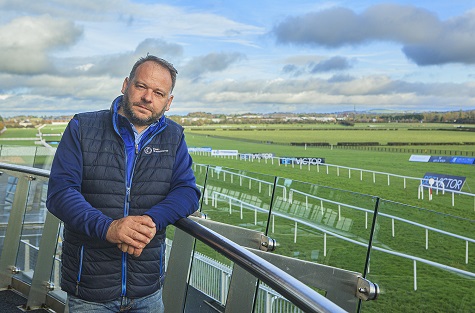
Roy Butler, the track foreman at Naas Racecourse
Three years later, I’m happy to report, that Roy has had no regrets. “I love the job here at Naas. There is a great atmosphere here among the workforce. The management here are savagely progressive and respect the professionalism of each of the departments, whether it is the catering section, the cleaners or my own department, they appreciate the work we do” said Roy. Since taking up the role as track foreman, €200,000 worth of machinery has been invested to maintain the track. Roy has already made an impression at Naas. In 2019, just a year after taking up the job, Naas racecourse was voted Racecourse of the Year. This was the first time that Naas received such an award. The Racecourse of the Year award did not take place in 2020, due to COVID-19.
The lockdown didn’t affect the work schedule at Naas racetrack as race meetings were still allowed to take place in Ireland, albeit behind closed doors. No member of the the public could attend, not even the horse owners, only the jockeys, trainers and grooms (one groom/horse). However, this didn’t lighten the work load for Roy and his team. The damage and repairs to the turf was just as plentiful as before and after the lockdowns.
The public are allowed to walk around the track on non meeting days. There is a tarmac pathway around the track to facilitate this. Walking was still allowed during lockdown, which was very much appreciated by the locals.
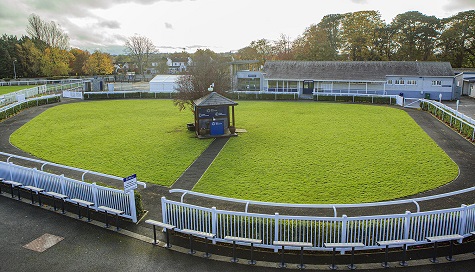
The parade ring and winners enclosure
The turf maintenance involves the same principals as that on a golf course, i.e. scarifying, vertidraining, overseeding, and irrigating when necessary. There is even an agronomist that Roy gets advice from. However, one notable difference between maintaing a golf course over a race track is that presentation is to the fore for a golf course while horse safety is paramount when maintaining a race track. The turf is mown at four inches in Summer, increasing to five inches in Winter. In times of drought, the race track is irrigated using a Briggs irrigation system. This was installed in 2016, costing €600,000 at the time and can provide 3mm – 25mm of water per day over the entire track. The water used is sourced from their own well and stored in a man made reservoir, located on the perimeter of the racecourse. During the drought of 2018, the reservoir came close to running dry, so, in the event of future droughts Roy hopes to double the capacity of the reservoir.
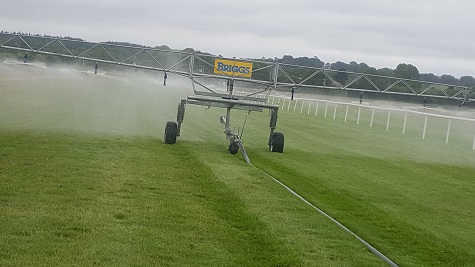
The irrigation system in full flow. Photo courtesy Roy Butler
Roy has five full time staff but this increases to twelve after each race meeting when track repairs need to be carried out. Up to 130 horses can run at any given meeting. The divots created after each race meeting must be quickly repaired prior to the next event so as to ensure the safety of the horses. Any injury to these top class horses will not only prove costly for the owner but a horse falling can also lead to injury to the jockey, so there is a lot of responsibility put on Roy and his team.
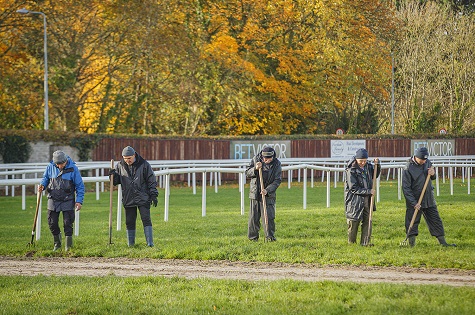
Extra staff are brought in to repair divots after a race meeting
Not long after Roy was employed he was concerned about the stretch of ground from the parade ring to the starting point. This section of turf was getting a lot of wear and tear so he suggested to management of installing a sand/fibre canter down to reduce the damage being caused to the turf. They agreed to this and installed the canter down to the top section. It has proved succssful and plans are in place to continue it down to the starting point.
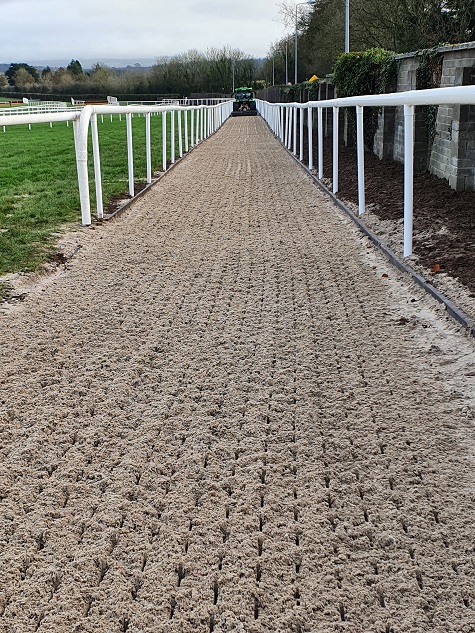
The addition of the canter down has reduced part of the track from wear and tear. Photo courtesy Roy Butler
Not only is Roy responsible for the maintenance of the turf on the racecourse, which is on a site covering almost 150 acres, but he must also ensure that the stables are kept in tip top condition. Since the equine flu occured, stricter rules have been put in place to keep the stables virus free. This involves completely removing the old litter; hoovering the stable floor; power washing and sanitising the stable before fresh shavings are placed in each stable. This involves a lot of work, especially when there are 150 stables, the most at any racecourse in Ireland. It is important to keep up with this routine as, from time to time, random visits are done by the Irish Equine Centre to check that the stables are up to standard and are free of viruses and fungi.

There are 150 stables at Naas, the most at any racecourse in Ireland
There are other subtle differences maintaining a race track. “We need to repair the fences for both the hurdles and steeplechase courses” said Roy. “The steeplechase fences are more permanent and demand a lot more maintenance. They consist of birch and evergreen tree branches, such as Leylandii, which need to be replaced and tied in regularly while the birch branches are kept in shape just like a hedge. These fences need to be moved from time to time so as to spread wear and tear on the turf, just like you do when moving tee markers on a golf course” continued Roy.
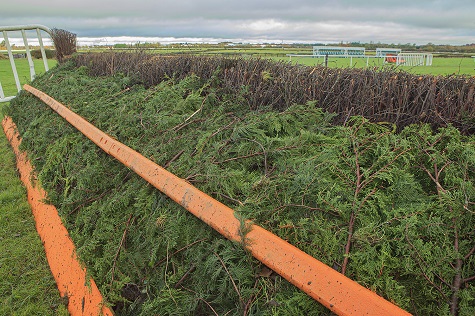
The steeplechase fences require a lot of maintenance
On the morning of a race meeting Roy inspects the condition of the track , along with the Clerk of the Course and the General Manager. Their assesments are sent to Horse Racing Ireland (HRI) who then publish it so that trainers know what condition the track is in. Each trainer, on foot of this report, will decide to enter a race, or not. During the races Roy must be on hand to deal with any emergencies that may arise such as horses or jockeys falling. He has screens at hand should the need arise. Roy even has the authority, with the coordination of the Clerk of the Course, to stop a race in certain situations.
Preparing for a race meeting not only involves keeping the turf in good condition. Other work involves making sure the running rails are straight, looking after the flower beds, hanging baskets and maintaining the parade ring to name but a few.
After a race meeting the track suffers from a lot of wear and tear so the rails need to be relocated before the next meeting. This involves lifting the rails and moving them two or three meters to the left or right. This could take four or five days to complete. Because the race track is one and a half miles it means that three miles of fencing need to be moved. Generally, there is a two or three week gap between meetings, which gives the team enough time to carry out the repairs. However, on occassions there may only be seven days to get the track back in ship shape condition.

Assistant track foreman Declan Harrington and John Gorey relocating the rails
I never realised how much work goes into maintaining a race track. The next time you go to Naas for a ‘Day at the Races’ or see it on TV, you should give Roy and his crew a thought and think of the work they have put in behind the scenes to provide you with a wonderful day out.
 |
|
|
|